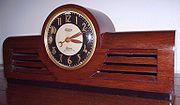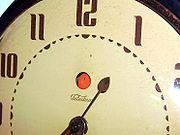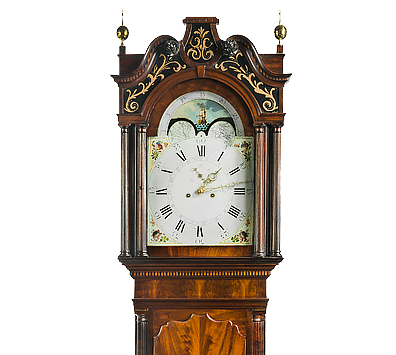Revere Telechron Clock History
Henry Warren established the company in 1912 in Ashland, Massachusetts. Initially, it was called “The Warren Clock Company,” producing battery-powered clocks. These proved unreliable, however, since batteries weakened quickly, which resulted in inaccurate time-keeping. Warren saw electric motors as the solution to this problem. In 1915, he invented a self-starting synchronous motor consisting of a rotor and a coil, which was patented in 1918. A synchronous motor spins at the same rate as the cycle of the alternating current driving it. Synchronous electric clocks had been available previously, but had to be started manually. In later years, Telechron would advertise its clocks as “bringing true time,” because power plants kept the frequency of the alternating current perfectly constant at 60 Hz. But such constancy did not yet exist when Warren first experimented with his synchronous motors. Irregularities in the frequency of the alternating current led not only to inaccurate time-keeping but, more seriously, to incompatible power-grids in the US, as power could not readily be transferred from one grid to another. In order to overcome these problems, Warren invented a “master clock,” which he installed at the Boston Edison Company in 1916. This clock had two movements, one driven by a synchronous motor connected to the current produced by the power plant, the other driven by a traditional spring and pendulum. The pendulum was adjusted twice a day in accordance with time signals received from the Naval Observatory. As long as the hands of the electric clock, powered by a 60 Hz synchronous motor, moved along perfectly with those of the “traditional” clock, the power produced by the electric company was uniform. In Electrifying Time, the standard work on Telechron clocks, Jim Linz writes that “in 1947, Warren Master Clocks regulated over 95 percent of the electric lines in the United States.”
It is interesting to note, then, that the uniformity of alternating current in the US, which was necessary to build large power-grids, was initially ensured by a very traditional clock system. Furthermore, Henry Warren invented his master clock at first simply in order to guarantee that his synchronous clock motor would provide accurate time.
Telechron and Art Deco
The Telechron Company’s success from the 1920s into the 1950s was not solely due to the engineering genius of its founder, although all Telechron clocks were powered by successive versions of Henry Warren’s synchronous motor. Rather, the Telechron company sought to produce clocks whose designs reflected one of the fundamental principles of the art deco movement: to combine modern engineering (including mass-production) with the beauty of simple geometric shapes. Thus, Telechron clocks are often genuine pieces of art—but pieces of art affordable by all, as thousands of them were made. The company employed some of the finest designers of the time, such as Leo Ivan Bruce (1911–1973) and John P. Rainbault. In the evolution of their designs, Telechron clocks are a faithful mirror of their own time. Just as a clock like the “Administrator” (designed by Leo Ivan Bruce) belongs in the thirties, so the “Dimension” was unquestionably fifties. Telechrons were relatively expensive compared to other clocks. In 1941, their most inexpensive alarm clock was the model 7H117 “Reporter,” and it sold for $2.95, the equivalent of $30.00 in 2008 funds. But their beautiful design and amazing reliability assured a brisk market for them throughout the company’s most prosperous years.






A Brief History of the Telechron Company
As noted above, Henry Warren initially named his company “The Warren Clock Company.” It became “Warren Telechron” in 1926. As early as 1917, General Electric acquired a strong interest in Telechron, realizing the economic potential of Warren’s invention. When Warren retired in 1943, General Electric gradually absorbed Telechron into its operations. The clocks labeled “Telechron” on the dial, as well as those labeled “General Electric” were both made in the Ashland, Massachusetts factory. GE clocks had their own case, dial and hand designs, as well as model names and numbers, but the internal workings of both brands of clock were always the same Telechron type of movement.

In addition to its association with GE, Telechron cooperated closely with one of America’s most famous maker of traditional clocks, the Herschede company. Walter Herschede became interested in synchronous clocks in the 1920s, but did not want to risk the good name of his company by associating it too quickly with the new technology. Thus, he founded the Revere Clock Company as a division of Herschede that would market clocks driven by Telechron motors. These motors, however, were housed in the elegant cases of mantel and grandfather clocks for which Herschede was known; moreover, these clocks were equipped with chimes.
Telechron—now the “Clock and Timer Division” of GE—declined in the 1950s, mainly because batteries had become much more long-lived and reliable. Battery-powered clocks have the obvious advantage of not depending on the proximity of a power outlet, and do not require the often somewhat unattractive electric cable. Furthermore, the accuracy of the quartz clock superseded the principles of the synchronous motor. GE tried to respond to the declining market for Warren’s technology by producing cheaper, less solidly manufactured clocks. Thus, plastic replaced bakelite or wood as the material for the cases; glass crystals were phased out in favor of plastic ones; and the much less durable S rotor took the place of the H rotor. Nevertheless, the decline of the synchronous clock could not be stopped. GE sold the last of its former Telechron plants in 1979. After successive attempts to revive the business remained fruitless, it closed permanently in 1992.
Nonetheless, even if Telechron’s original operations have ceased, Telechron continues to exist as a brand: Telechron is the name used by a manufacturer of electric timers in Leland, North Carolina. Moreover, a company that spun off from one of Telechron’s research labs in 1928 is still flourishing: Electric Time Company,manufactures custom tower and post clocks in Medfield, Massachusetts. Electric Time is the only such company in the US that still makes its own clock movements.
Limitations of the Telechron Technology

As we have seen, from a commercial point of view, it was the increased durability of batteries as well as the invention of the quartz movement that proved fatal to Telechron. From the point of view of the history of technology, however, another problem is more crucial: if the electric power grid is used as a system for the “distribution of time,” as Warren himself wrote, then, in the case of a power failure, the individual consumers’ Telechrons lose their connection with the master clock (and, by implication, with the time provided by the Naval Observatory). More simply put, the clocks stop. Warren, foreseeing this difficulty, provided his clocks with an “indicating device”: a red dot that would appear on the dial whenever the power failed. This red dot alerted the consumer to the need to reset the clock (by obtaining the accurate time through the telephone, for example, or from a radio), after which the indicating device could be switched back to the dial color. However, the fact remains that there was a potential hole in Warren’s ingenious system of time distribution. The electric clock market grew rapidly in the 1930s, and the problem with power interruptions affected all brands of electric clock, of course, but only those made by Telechron or General Electric had the power indicating device, which Warren had wisely patented.
This problem was finally overcome by the radio clock,which receives its time signals not through the electric grid, but from radio transmitters.
Collecting Telechron Clocks
There is a growing community of hobbyists who collect Telechron clocks, which testify impressively to a now bygone era of solid engineering and American manufacturing; an era which contrasts with the contemporary “throw-away” culture of disposable consumer goods. A Telechron clock, bought for a few dollars from a dusty antique store, will usually come to life immediately—though sometimes noisily—when it is plugged in; the type “H” rotor, in particular, is known for running smoothly for 50, 60 or even more years without any mechanical breakdown or loss of accuracy. The beauty of the design of many of the Telechrons adds to their attraction. Since Telechrons were mass-produced, the most common models will usually sell for between 15 and 40 dollars on websites such as eBay.
Telechron Alarm Clocks
Telechron alarm clocks are particularly popular with collectors. Until about 1940, the overwhelming majority of Telechron alarm clocks had bell alarms, likely as a nod to the very popular “Big Ben” alarms made by Westclox. The entire mechanism was enclosed in a bell housing of steel. Atop the clock’s coil was a metal strip that vibrated at 60 cycles per second when the alarm was tripped. This strip had a V-shaped arm attached to it, ending in a striker, which vibrated in turn against the bell housing. With the approach of war, restrictions on various metals required a reduction in their use, and the bell housing was eliminated, with only the metal strip above the coil remaining. This in itself, however, provided a loud buzz when the alarm was tripped (and was the basis of the alarm in all brands of alarm clocks for many years after the war). Post-war, very few Telechrons had bell alarms, and the bell had disappeared completely by 1960. Telechron was one of the first companies—and may have been the first—to introduce what became known as the “snooze” alarm in the early 1950s.

Ship Your Clock for Expert Repairs!
Expert Shipping Instructions!

Grandfather Clock Service Calls
We make Grandfather Clock service calls!

Contact Us
Feel free to contact us any time at (215) 862-2415.

Further Questions?
We'd like to hear from you!
People Say




